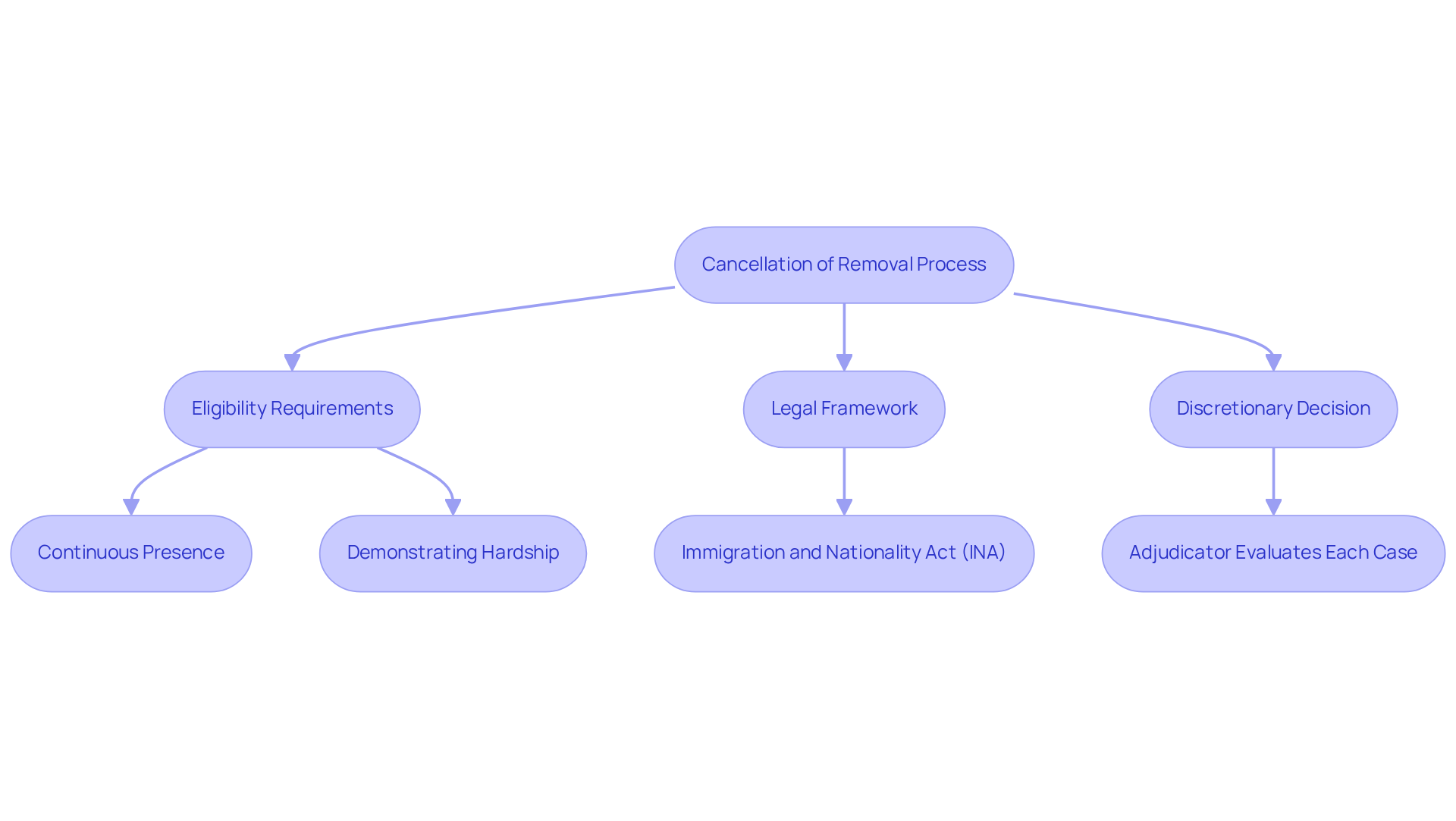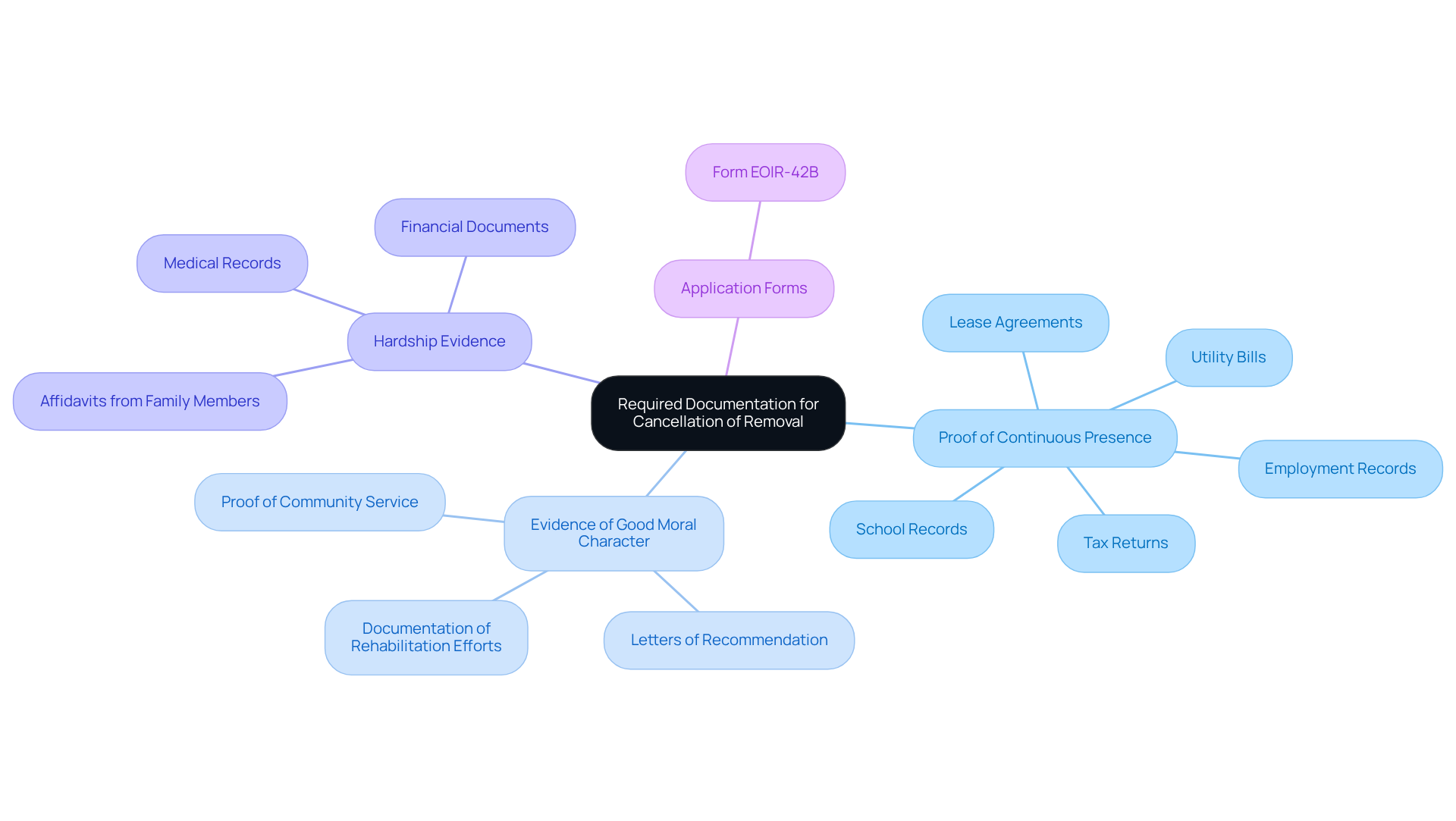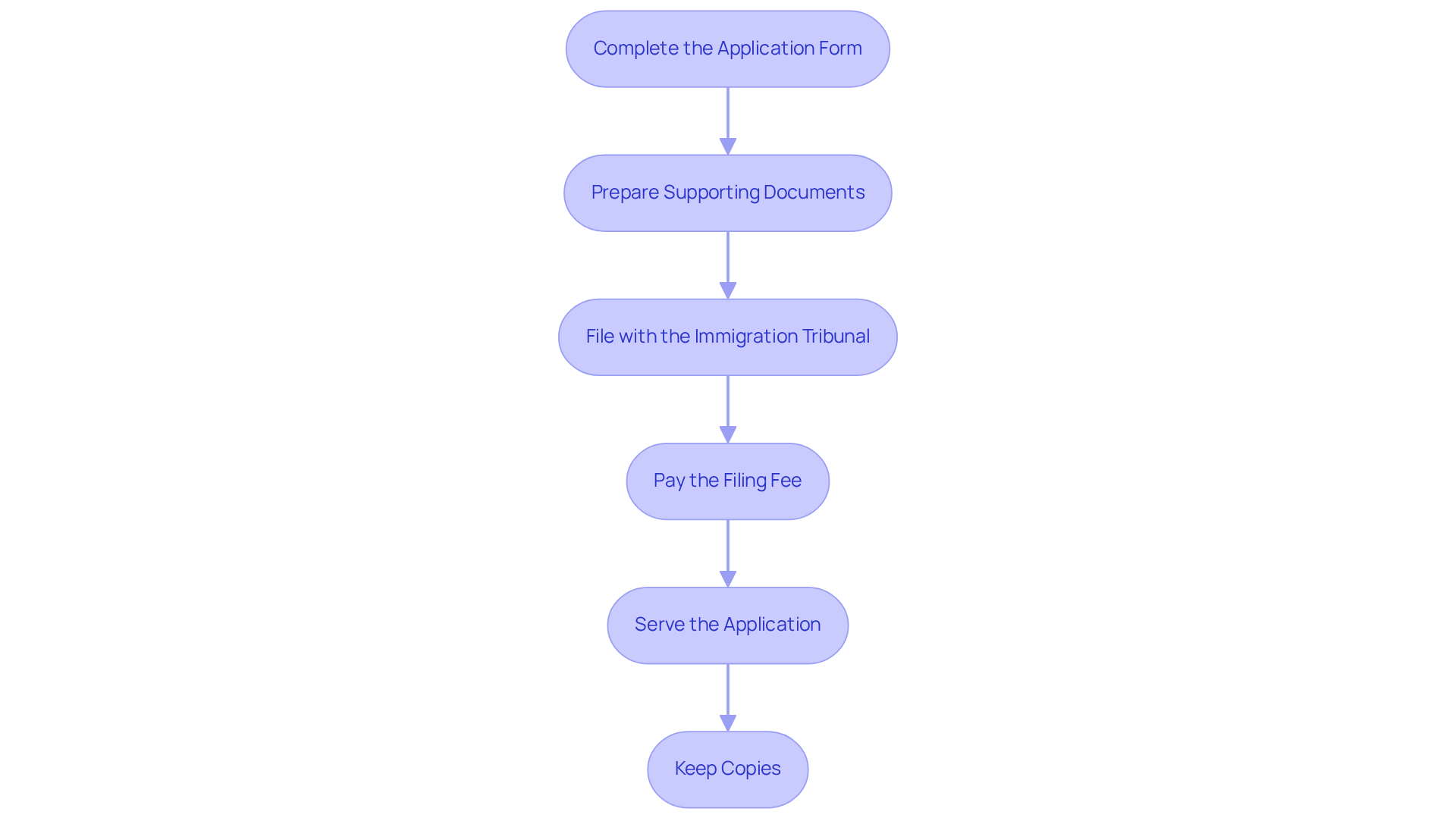Overview
This article serves as a practical, step-by-step guide on the cancellation of removal process. It empowers individuals facing deportation by outlining how they can remain in the United States if they meet specific eligibility criteria. We understand how overwhelming this process can be. Gathering the necessary documentation, filing the application correctly, and navigating the discretionary nature of the process governed by the Immigration and Nationality Act are crucial steps. This guide highlights the complexities and potential pitfalls applicants may encounter, reminding you: you’re not alone in this fight. We’re here to support you every step of the way.
Introduction
Navigating the complexities of immigration law can feel overwhelming, especially when the threat of deportation looms. The cancellation of removal process serves as a crucial lifeline for non-permanent residents who have put down roots in the United States. However, the journey to securing this relief is filled with obstacles. This guide explores the essential steps and criteria for successfully navigating the cancellation of removal, empowering individuals to understand their rights and the necessary documentation to strengthen their case.
What happens when the stakes are high and the outcome is uncertain? Grasping these intricacies could mean the difference between staying in the country and facing expulsion.
Understand the Cancellation of Removal Process
Cancellation of deportation is a vital relief option that allows certain individuals facing expulsion to remain in the United States. This process is especially pertinent for non-permanent residents who have lived in the country for at least ten years and can demonstrate good moral character. However, the annulment of deportation is not guaranteed; it is a discretionary form of assistance granted by an immigration judge based on specific eligibility criteria. Understanding this process is crucial for anyone navigating deportation procedures, as it can pave the way to legal residency and stability in the U.S.
If you receive a subpoena or encounter ICE enforcement actions, knowing your rights and acting promptly is essential. You have the right to remain silent, the right to an attorney, and the right not to sign documents without legal counsel. If you find yourself in such a situation, do not open your door unless ICE presents a warrant signed by a judge. Exercise your right to remain silent and request an attorney immediately. For urgent legal assistance, contact Vasquez Law Firm at our emergency line, available 24/7 for critical legal matters.
Key aspects of the cancellation of removal process include:
- Eligibility Requirements: Applicants must meet certain criteria, including continuous presence in the U.S. and demonstrating hardship to qualifying relatives.
- Legal Framework: The process is governed by the Immigration and Nationality Act (INA), which outlines the specific provisions related to the cancellation of removal.
- Discretionary Nature: Even if an applicant meets all requirements, the final decision on the cancellation of removal lies with the adjudicator, who will evaluate the merits of each case individually.
At Vasquez Law Firm, we are committed to providing comprehensive legal services, including immigration, personal injury, criminal defense, family law, and traffic violations. We ensure that you receive the support you need during these challenging times. Remember, we’re here to fight for your family and your future matters to us. Yo Peleo — We Fight.

Determine Eligibility for Cancellation of Removal
To qualify for cancellation of removal, applicants must meet several critical eligibility criteria:
-
Continuous Presence: You need to show that you’ve been physically present in the United States for at least ten years before deportation proceedings begin. This requirement is crucial, as the stop-time rule under the Illegal Immigration Reform and Immigrant Responsibility Act (IIRIRA) states that continuous presence ends when a notice to appear is served.
-
Good Moral Character: It’s essential to demonstrate good moral character throughout that ten-year period. This typically means having no serious criminal convictions. Maintaining a clean record is vital; even minor infractions can jeopardize your eligibility.
-
Hardship to Qualifying Relatives: You must provide evidence that your departure would cause exceptional and extremely unusual hardship to a qualifying relative, such as a U.S. citizen or lawful permanent resident spouse, parent, or child. Factors that influence this determination include the qualifying relative's age, health, and how your absence might affect their standard of living.
-
Not a Security Risk: You must not pose a threat to national security or public safety. This evaluation is essential to ensure that individuals granted relief from deportation do not put the community at risk.
Gathering strong evidence to support your claims regarding continuous presence, good moral character, and potential hardship is vital for the cancellation of removal. This documentation will significantly impact the next steps in the process to annul your status. With nearly 250,000 applications for non-LPR annulment currently pending, it’s clear that this legal avenue is competitive, but you don’t have to navigate it alone. We’re here to fight for your family and your future.

Gather Required Documentation and Evidence
Gathering the right paperwork is crucial for successfully navigating the cancellation of removal application process. Have you ever felt overwhelmed by the requirements? Here are the key documents you should gather:
- Proof of Continuous Presence: This can include utility bills, lease agreements, employment records, school records, and tax returns.
- Evidence of Good Moral Character: Collect documents that demonstrate your good moral character, such as letters of recommendation from employers, community leaders, or religious institutions, proof of community service or involvement, and documentation of any rehabilitation efforts if applicable.
- Hardship Evidence: To prove exceptional hardship for the cancellation of removal, gather medical records for yourself or your qualifying relatives, financial documents showing dependency on your income, and affidavits from family members detailing the impact of the cancellation of removal.
- Application Forms: Ensure you have the correct forms, like Form EOIR-42B for non-permanent residents, completed and ready for submission.
Arranging these documents clearly will help present a compelling argument for the cancellation of removal to the judge. Remember, you’re not alone in this fight—we’re here to support you every step of the way.

File Your Cancellation of Removal Application
Once you have gathered all necessary documentation, the next step is to file your application for cancellation of removal. Follow these steps:
- Complete the Application Form: Accurately fill out Form EOIR-42B, ensuring all information is correct and complete.
- Prepare Supporting Documents: Attach all supporting documentation that demonstrates your eligibility and hardship. Clearly label and organize each document for easy reference.
- File with the Immigration Tribunal: Submit your application to the relevant tribunal based on your location and situation details. Understanding the court system is crucial; familiarize yourself with what to expect during hearings and trials.
- Pay the Filing Fee: Include the required filing fee with your application. As of 2025, the fee is a minimum of $100, but verify the most current fee schedule to avoid surprises, as new fees established by H.R. 1 may apply.
- Serve the Application: Ensure that a copy of your application is served to the Assistant Chief Counsel for the Department of Homeland Security (DHS).
- Keep Copies: Make copies of everything you submit for your records. This is essential for future reference and in the event of any disputes.
Filing your application correctly and on time is essential to ensure the cancellation of removal, as mistakes can lead to significant delays or denials. Statistics indicate that filing errors in immigration applications remain a common issue, with many applicants facing challenges due to incomplete forms or missing documentation. Immigration lawyers often emphasize that these errors are among the most common, which can endanger your situation. Therefore, meticulous preparation is vital. Additionally, consider accessing important legal resources and forms, such as the 'Court Guide' and 'Download Forms,' to assist you in navigating this process effectively.

Navigate Challenges and Common Pitfalls
Navigating the termination of the process can be challenging. Here are some common pitfalls to avoid and strategies to help you through:
-
Incomplete Applications: Make sure your application is complete and includes all required documents. Missing information can lead to delays or denials.
-
Failure to Demonstrate Hardship: Proving exceptional hardship can be one of the toughest parts of the application. Be thorough in your documentation and consider seeking expert opinions when necessary.
-
Ignoring Deadlines: Stay vigilant about filing deadlines and court dates. Missing a deadline could mean losing your chance for relief.
-
Not Seeking Legal Assistance: Not seeking legal assistance can be detrimental; therefore, if you encounter challenges, it’s wise to consult a lawyer who specializes in cancellation of removal matters. Their expertise can provide valuable guidance and enhance your chances of success. Remember, if you receive a subpoena or face immigration enforcement actions, it’s crucial to exercise your right to remain silent and request an attorney immediately. Contact Vasquez Law Firm for urgent legal assistance, available 24/7.
-
Being Unprepared for the Hearing: If your case goes to a hearing, prepare to present your argument clearly and confidently. Practice your testimony and be ready to answer questions from the judge.
By staying aware of these challenges and preparing accordingly, you can significantly improve your chances of successfully navigating the cancellation of removal. At Vasquez Law Firm, we work on a contingency fee basis for personal injury cases, ensuring that financial constraints do not stand in the way of seeking the justice you deserve.

Conclusion
Understanding the cancellation of removal process is crucial for individuals facing deportation, as it offers a potential pathway to legal residency in the United States. This process involves not just meeting eligibility criteria, but also effectively navigating complexities, from gathering necessary documentation to filing the application correctly. With the right knowledge and support, applicants can significantly enhance their chances of success in this discretionary relief option.
The article outlines essential components of the cancellation of removal process, including eligibility requirements such as:
- Continuous presence
- Good moral character
- Demonstrating hardship to qualifying relatives
It stresses the importance of meticulous preparation, from collecting supporting evidence to avoiding common pitfalls like incomplete applications and missed deadlines. This guidance serves as a roadmap to help individuals steer clear of mistakes that could jeopardize their cases.
Ultimately, the significance of the cancellation of removal process extends beyond individual cases; it embodies hope and stability for families facing uncertainty. By understanding the requirements and seeking legal assistance when necessary, individuals can take proactive steps toward securing their future in the U.S. Embracing this journey with informed determination can profoundly impact the lives of those affected. We’re here to fight for your family. Your future matters to us. Yo Peleo — We Fight.
Frequently Asked Questions
What is the cancellation of removal process?
The cancellation of removal process is a relief option that allows certain individuals facing deportation to remain in the United States. It is particularly relevant for non-permanent residents who have lived in the U.S. for at least ten years and can demonstrate good moral character.
Who is eligible for cancellation of removal?
To qualify for cancellation of removal, applicants must have continuous presence in the U.S. for at least ten years, demonstrate good moral character, show that their departure would cause exceptional hardship to a qualifying relative, and not pose a security risk.
What does "continuous presence" mean in the context of cancellation of removal?
Continuous presence means that the individual has been physically present in the United States for at least ten years before the deportation proceedings begin. This requirement is affected by the stop-time rule, which states that continuous presence ends when a notice to appear is served.
What constitutes "good moral character" for cancellation of removal?
Good moral character typically means having no serious criminal convictions during the ten-year period of continuous presence. Even minor infractions can jeopardize eligibility.
What is considered "hardship to qualifying relatives"?
Hardship to qualifying relatives refers to the exceptional and extremely unusual difficulties that a qualifying relative (such as a U.S. citizen or lawful permanent resident spouse, parent, or child) would face if the applicant were deported. Factors include the relative's age, health, and the impact on their standard of living.
Is the cancellation of removal guaranteed?
No, the cancellation of removal is not guaranteed. It is a discretionary form of relief granted by an immigration judge based on specific eligibility criteria and the merits of each individual case.
What should I do if I encounter ICE enforcement actions?
If you encounter ICE enforcement actions, you have the right to remain silent, the right to an attorney, and the right not to sign documents without legal counsel. Do not open your door unless ICE presents a warrant signed by a judge, and request an attorney immediately.
How can I get legal assistance for the cancellation of removal process?
For urgent legal assistance, you can contact Vasquez Law Firm, which offers support for immigration issues and other legal matters. They provide comprehensive legal services and are available 24/7 for critical legal situations.




